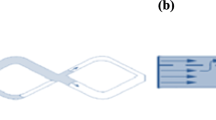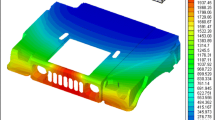Abstract
This paper addresses the numerical simulation of void formation and transport during mold filling in Resin Transfer Molding (RTM). The saturation equation, based on a two-phase flow model resin/air, is coupled with Darcy’s law and mass conservation to simulate the unsaturated filling flow that takes place in a RTM mold when resin is injected through the fiber bed. These equations lead to a system composed of an advection–diffusion equation for saturation including capillary effects and an elliptic equation for pressure taking into account the effect of air residual saturation. The model introduces the relative permeability as a function of resin saturation. When capillary effects are omitted, the hyperbolic nature of the saturation equation and its strong coupling with Darcy equation through relative permeability represent a challenging numerical issue. The combination of the constitutive physical laws relating permeability to saturation with the coupled system of the pressure and saturation equations allows predicting the saturation profiles. The model was validated by comparison with experimental data obtained for a fiberglass reinforcement injected in a RTM mold at constant flow rate. The saturation measured as a function of time during the resin impregnation of the fiber bed compared very well with numerical predictions.






Similar content being viewed by others
References
Patel N, Lee LJ (1996) Modeling of void formation and removal in liquid composite molding. Part I: wettability analysis. Polym Compos 17(1):96–103
Ruiz E, Achim V, Soukane S, Trochu F, Bréard J (2006) Optimization of injection flow rate to minimize micro/macro-voids formation in resin transfer molded composites. Compos Sci Technol 66(3–4):475–486
Trochu F, Ruiz E, Achim V, Soukane S (2006) Advanced numerical simulation of liquid composite molding for process analysis and optimization. Compos A: Appl Sci Manuf 37(6):890–902
Park CH, Lee W (2011) Modeling void formation and unsaturated flow in liquid composite molding processes: a survey and review. J Reinf Plast Compos 30(11):957–977
Pillai KM (2004) Modeling the unsaturated flow in liquid composite molding processes: a review and some thoughts. J Compos Mater 38(23):2097–2118
Breard J, Saouab A, Bouquet G (2003) Numerical simulation of void formation in LCM. Compos A: Appl Sci Manuf 34:517–523
Breard J, Henzel Y, Trochu F, Gauvin R (2003) Analysis of dynamic flows through porous media. Part I: comparison between saturated and unsaturated flows in fibrous reinforcements. Polym Compos 24(3):391–408
Parnas RS, Phelan FR Jr (1991) The effect of heterogeneous porous media on mold filling in Resin Transfer Molding. SAMPE Q 22(2):53–60
Parseval DY, Pillai KM, Advani SG (1997) A simple model for the variation of permeability due to partial saturation in dual scale porous media. Transp Porous Media 27(3):243–264
Pillai KM (2002) Governing equations for unsaturated flow through woven fiber mats. Part 1. Isothermal flows. Compos A: Appl Sci Manuf 33(7):1007–1019
Simacek P, Advani SG (2003) A numerical model to predict fiber tow saturation during Liquid Composite Molding. Compos Sci Technol 63:1725–1736
García JA, Gascón L, Chinesta F (2010) A flux limiter strategy for solving the saturation equation in RTM process simulation. Compos A: Appl Sci Manuf 41:78–82
Chui WK, Glimm J, Tangerman FM, Jardine AP, Madsen JS, Donnellan TM, Leek R (1997) Process modeling in Resin Transfer Molding as a method to enhance product quality. SIAM Rev 39(4):714–727
Nordlund M, Michaud V (2012) Dynamic saturation curve measurement for resin flow in glass fibre reinforcement. Compos A: Appl Sci Manuf 43:333–343
García JA, Ll G, Chinesta F (2003) A fixed mesh numerical method for modelling the flow in liquid composites moulding processes using a volume of fluid technique. Comput Methods Appl Mech Eng 192(7–8):877–893
García JA, Ll G, Chinesta F, Trochu F, Ruiz E (2010) An efficient solver of the saturation equation in liquid composite molding processes. Int J Mater Form 3(2):1295–1302
Lebel F (2012) Contrôle de la fabrication des composites par injection sur renforts. École Polytechnique de Montréal, Canada
Van Genuchten MT (1980) Closed-form equation for predicting the hydraulic conductivity of unsaturated soils. Soil Sci Soc Am J 44(5):892–898
Buckley SE, Leverett MC (1942) Mechanism of fluid displacement in sands. Pet Trans AWME 146:107–116
Lundstrom TS, Gebart BR (1994) Influence from process parameters on void formation in Resin Transfer Molding. Polym Compos 15(1):25–33
Lundstrom TS (1997) Measurement of void collapse during Resin Transfer Molding. Compos A: Appl Sci Manuf 28(3):201–214
Lundstrom TS, Frishfelds V, Jakovics A (2010) Bubble formation and motion in non-crimp fabrics with perturbed bundle geometry. Compos A: Appl Sci Manuf 41:83–92
Lebel F, Fanaei A, Ruiz E, Trochu F (2012) Experimental characterization by fluorescence of capillary flows in the fiber tows of engineering fabrics. Open J Inorg Non-Metallic Mater 2(3):25–45
Brooks RH, Corey AT (1964) Hydraulic properties of porous media. Colorado State University. Hydrology Papers 1–37
Corey AT (1954) The interrelation between gas and oil relative permeabilities. Prod Monthly 19(1):38–41
Acknowledgments
The authors acknowledge financial support of the Spanish Government (Projects DPI2010-20333 and DPI2013-44903-R-AR), of the National Science and Research Council of Canada (NSERC) and of the Canada Reseach Chair (CRC) program.
Author information
Authors and Affiliations
Corresponding author
Rights and permissions
About this article
Cite this article
Gascón, L., García, J.A., LeBel, F. et al. A two-phase flow model to simulate mold filling and saturation in Resin Transfer Molding. Int J Mater Form 9, 229–239 (2016). https://doi.org/10.1007/s12289-015-1225-z
Received:
Accepted:
Published:
Issue Date:
DOI: https://doi.org/10.1007/s12289-015-1225-z




